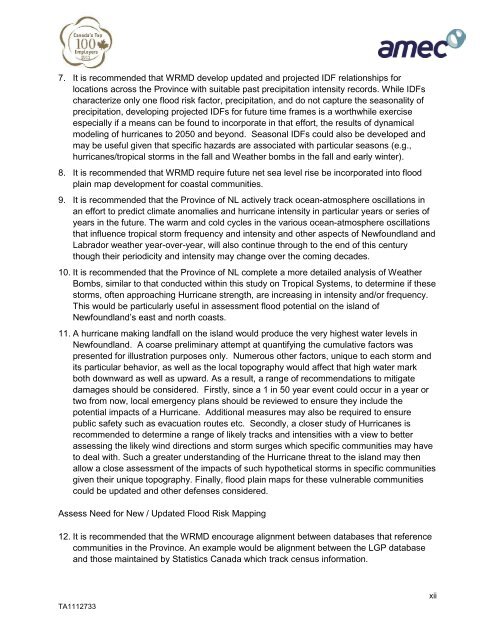Flood Risk and Vulnerability Analysis Project - Atlantic Climate ...
Flood Risk and Vulnerability Analysis Project - Atlantic Climate ...
Flood Risk and Vulnerability Analysis Project - Atlantic Climate ...
You also want an ePaper? Increase the reach of your titles
YUMPU automatically turns print PDFs into web optimized ePapers that Google loves.
7. It is recommended that WRMD develop updated <strong>and</strong> projected IDF relationships for<br />
locations across the Province with suitable past precipitation intensity records. While IDFs<br />
characterize only one flood risk factor, precipitation, <strong>and</strong> do not capture the seasonality of<br />
precipitation, developing projected IDFs for future time frames is a worthwhile exercise<br />
especially if a means can be found to incorporate in that effort, the results of dynamical<br />
modeling of hurricanes to 2050 <strong>and</strong> beyond. Seasonal IDFs could also be developed <strong>and</strong><br />
may be useful given that specific hazards are associated with particular seasons (e.g.,<br />
hurricanes/tropical storms in the fall <strong>and</strong> Weather bombs in the fall <strong>and</strong> early winter).<br />
8. It is recommended that WRMD require future net sea level rise be incorporated into flood<br />
plain map development for coastal communities.<br />
9. It is recommended that the Province of NL actively track ocean-atmosphere oscillations in<br />
an effort to predict climate anomalies <strong>and</strong> hurricane intensity in particular years or series of<br />
years in the future. The warm <strong>and</strong> cold cycles in the various ocean-atmosphere oscillations<br />
that influence tropical storm frequency <strong>and</strong> intensity <strong>and</strong> other aspects of Newfoundl<strong>and</strong> <strong>and</strong><br />
Labrador weather year-over-year, will also continue through to the end of this century<br />
though their periodicity <strong>and</strong> intensity may change over the coming decades.<br />
10. It is recommended that the Province of NL complete a more detailed analysis of Weather<br />
Bombs, similar to that conducted within this study on Tropical Systems, to determine if these<br />
storms, often approaching Hurricane strength, are increasing in intensity <strong>and</strong>/or frequency.<br />
This would be particularly useful in assessment flood potential on the isl<strong>and</strong> of<br />
Newfoundl<strong>and</strong>‟s east <strong>and</strong> north coasts.<br />
11. A hurricane making l<strong>and</strong>fall on the isl<strong>and</strong> would produce the very highest water levels in<br />
Newfoundl<strong>and</strong>. A coarse preliminary attempt at quantifying the cumulative factors was<br />
presented for illustration purposes only. Numerous other factors, unique to each storm <strong>and</strong><br />
its particular behavior, as well as the local topography would affect that high water mark<br />
both downward as well as upward. As a result, a range of recommendations to mitigate<br />
damages should be considered. Firstly, since a 1 in 50 year event could occur in a year or<br />
two from now, local emergency plans should be reviewed to ensure they include the<br />
potential impacts of a Hurricane. Additional measures may also be required to ensure<br />
public safety such as evacuation routes etc. Secondly, a closer study of Hurricanes is<br />
recommended to determine a range of likely tracks <strong>and</strong> intensities with a view to better<br />
assessing the likely wind directions <strong>and</strong> storm surges which specific communities may have<br />
to deal with. Such a greater underst<strong>and</strong>ing of the Hurricane threat to the isl<strong>and</strong> may then<br />
allow a close assessment of the impacts of such hypothetical storms in specific communities<br />
given their unique topography. Finally, flood plain maps for these vulnerable communities<br />
could be updated <strong>and</strong> other defenses considered.<br />
Assess Need for New / Updated <strong>Flood</strong> <strong>Risk</strong> Mapping<br />
12. It is recommended that the WRMD encourage alignment between databases that reference<br />
communities in the Province. An example would be alignment between the LGP database<br />
<strong>and</strong> those maintained by Statistics Canada which track census information.<br />
TA1112733<br />
xii














